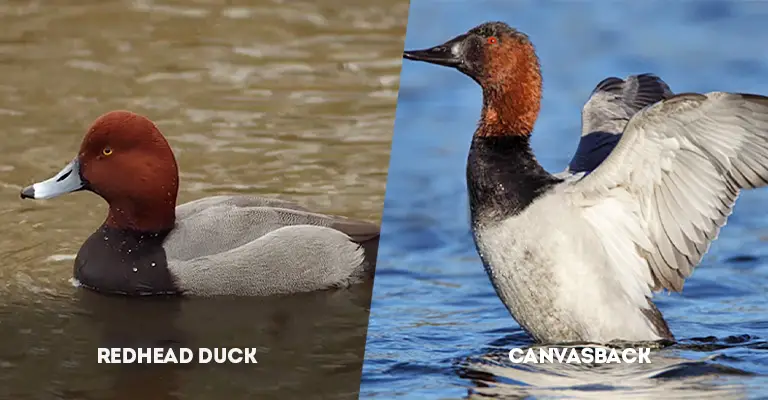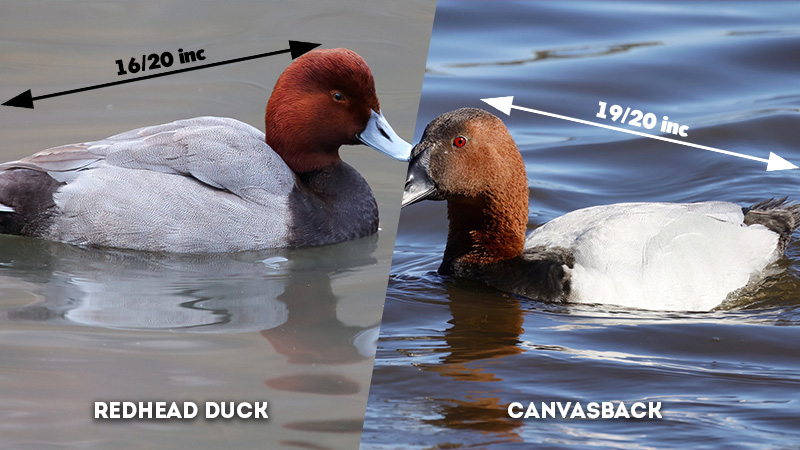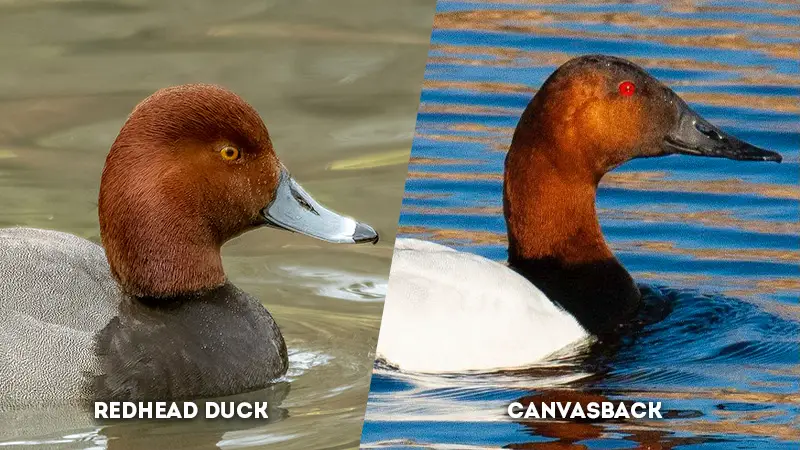Redhead and Canvasback ducks, two distinct species of diving ducks, grace North American waterways with their unique characteristics and behaviors. While sharing certain traits, they each possess defining features that set them apart.
From their migratory patterns and habitat preferences to bill adaptations and social behaviors, these ducks epitomize the diversity of avian life.
In this exploration, we delve into lesser-discussed aspects of these ducks’ lives, shedding light on their interactions with their environments and fellow inhabitants.
By unraveling their nuanced behaviors and ecological roles, we gain a deeper appreciation for the intricate tapestry of nature’s creations.

Key Differences Between Redhead Duck and Canvasback
Here’s a table outlining 20 key differences between the Redhead duck and the Canvasback duck:.
Size

- Redhead Duck: The Redhead duck (Aythya americana) is of moderate size, measuring around 16-20 inches in length and weighing between 1.5-2.5 pounds. Its size places it among the smaller diving duck species.
This relatively compact stature allows the Redhead to maneuver efficiently in its aquatic habitats, diving for food and navigating through water vegetation. - Canvasback Duck: In contrast, the Canvasback duck (Aythya valisineria) is notably larger. It ranges between 19-22 inches in length and weighs around 2-3 pounds. The Canvasback’s larger size is advantageous for its lifestyle, as it often feeds on a diet that includes submerged aquatic plants and invertebrates.
This larger body size might provide the Canvasback with enhanced buoyancy and diving capabilities to forage in deeper waters.
Head Shape

- Redhead Duck: The Redhead duck (Aythya americana) displays a distinctive head shape characterized by its rounded appearance. This rounded head forms a pronounced angle where it meets the bill.
This creates a classic duck profile that’s immediately recognizable. The head’s curvature gives the Redhead a traditional, quintessential duck appearance, which is familiar to many birdwatchers and enthusiasts. - Canvasback Duck: Conversely, the Canvasback duck (Aythya valisineria) boasts a head shape that sets it apart. Its long, sloping forehead blends seamlessly into the bill without any noticeable angle.
This unbroken line from the top of the forehead to the tip of the bill gives the Canvasback a unique and striking profile. This elongated face distinguishes it from other duck species and provides an elegant and sleek look.
Bill Color
- Redhead Duck: The Redhead duck features a distinctive blue-gray bill. This bluish hue contrasts with the duck’s overall plumage, making the bill a standout feature.
The blue-gray bill contributes to the duck’s visual appeal and makes it easily identifiable, particularly when observed in close proximity. - Canvasback Duck: On the other hand, the Canvasback duck sports a bill that is blackish in color. This darker bill shade complements the overall appearance of the duck and harmonizes with its varied shades of brown and gray plumage.
The Canvasback’s bill coloration serves not only as an aesthetic characteristic but also as an adaptation for its feeding habits and habitat.
Bill Shape
- Redhead Duck: The bill of the Redhead duck is relatively shorter and broader compared to other diving ducks. This shape suits its dietary preferences, which include consuming aquatic vegetation and various invertebrates. The bill’s width allows the Redhead to capture and process a range of food items efficiently.
- Canvasback Duck: The Canvasback’s bill, in contrast, is longer and narrower. This bill configuration aligns with its feeding behavior, which involves diving for food such as aquatic plants and invertebrates.
The longer bill enables the Canvasback to access its preferred food sources more effectively, even in deeper waters.
Profile
- Redhead Duck: The Redhead’s profile is characterized by the distinctive angle between its rounded head and its bill. This angle creates a well-defined transition between the two, offering a more classic and recognizable duck appearance.
The pronounced curvature of the head gives the Redhead its characteristic charm and is often a defining feature when identifying this species. - Canvasback Duck: The Canvasback’s profile is marked by the absence of a noticeable angle between its head and bill. Instead, its long, sloping face creates an uninterrupted line that runs from the top of the forehead to the tip of the bill.
This unique profile contributes to the Canvasback’s elegant and elongated appearance, setting it apart from other ducks and making it a visually striking species.
Habitat
- Redhead Duck: The Redhead duck (Aythya americana) thrives in a variety of freshwater habitats, including lakes, ponds, marshes, and shallow wetlands.
These habitats offer abundant aquatic vegetation and invertebrates, which are essential components of the Redhead’s diet.
The adaptable nature of its habitat preference allows the Redhead to occupy a wide range of environments across North America. - Canvasback Duck: Canvasback ducks (Aythya valisineria) tend to inhabit slightly different aquatic environments. They are often found in larger bodies of water, such as lakes, reservoirs, and coastal estuaries.
These habitats provide the deeper waters necessary for the Canvasback’s feeding behavior, as they dive to forage on aquatic plants and invertebrates found at various depths.
Migration
- Redhead Duck: Redhead ducks exhibit a migratory behavior that involves traveling between their breeding grounds in northern North America and their wintering areas in more temperate regions.
These migratory patterns help the Redhead find suitable habitats and food sources as the seasons change. - Canvasback Duck: Similar to the Redhead, Canvasback ducks also engage in migratory behavior.
They breed in northern areas of North America and undertake long journeys to reach warmer wintering grounds, often along coastlines or in areas with open water bodies.
Feeding Behavior
- Redhead Duck: The Redhead duck’s feeding behavior involves diving underwater to obtain its food. It primarily feeds on aquatic vegetation, such as submerged plants and seeds, along with various invertebrates found in water bodies. This behavior allows the Redhead to access a diverse array of food sources.
- Canvasback Duck: Canvasback ducks are skilled divers as well, using their diving ability to access underwater plants and invertebrates.
Their feeding behavior is well-suited for their diet, which includes consuming aquatic plants, roots, stems, and seeds, as well as small crustaceans and mollusks.
Diet
- Redhead Duck: The Redhead’s diet consists of a mix of aquatic vegetation and invertebrates. They consume submerged plants, seeds, and small aquatic creatures like insects and crustaceans. This adaptable diet helps sustain them across various freshwater habitats.
- Canvasback Duck: Canvasback ducks have a similar dietary preference for aquatic vegetation and invertebrates.
They are known for their fondness for eating the tubers and roots of aquatic plants, which provide them with energy for their migratory journeys and reproductive efforts.
Plumage
- Redhead Duck: The Redhead duck’s plumage is characterized by a mix of brown and gray tones. Their body feathers display variations in shades, which help them blend into their natural habitats.
Males often exhibit a reddish-brown head and neck during the breeding season, which fades to a more muted color during the non-breeding months. - Canvasback Duck: Canvasback ducks also have an intricate plumage pattern, with various shades of brown and gray.
Males sport a distinctive chestnut-red head and neck during breeding, which contrasts with their blackish breasts and white sides. Their unique plumage adds to their visual appeal and aids in species identification.
Breeding Range
- Redhead Duck: The breeding range of the Redhead duck (Aythya americana) encompasses northern parts of North America, including Canada and parts of the northern United States. These areas provide the necessary nesting sites and suitable habitats for the Redhead’s reproductive activities.
- Canvasback Duck: Canvasback ducks also breed in northern North America, with their breeding range overlapping that of the Redhead. They nest in similar regions, taking advantage of the freshwater habitats and resources available for successful reproduction.
Bill Adaptation
- Redhead Duck: The bill of the Redhead duck is well adapted to its feeding habits. The broader and shorter bill allows the Redhead to efficiently capture and process a variety of aquatic vegetation and invertebrates, contributing to its dietary flexibility.
- Canvasback Duck: The Canvasback’s longer, narrower bill is adapted for its specific diet, which includes diving for submerged aquatic plants and invertebrates. This bill shape aids in reaching and extracting food sources from various depths within water bodies.
Head-bill Transition
- Redhead Duck: The Redhead’s head-bill transition features a notable angle between its rounded head and its bill. This angle creates a distinctive profile that sets it apart from other duck species, giving it a recognizable and classic appearance.
- Canvasback Duck: The Canvasback duck lacks the pronounced angle between its head and bill. Instead, it boasts a smooth, unbroken transition from its long forehead to the tip of its bill. This unique profile contributes to its elegant and elongated appearance.
Voice
- Redhead Duck: Redhead ducks are generally known to be relatively silent birds. They don’t exhibit a wide range of vocalizations, which is in contrast to some other duck species that produce more distinct calls.
- Canvasback Duck: Canvasback ducks are more vocal during specific contexts, particularly during the breeding season. Males can produce various vocalizations that are often associated with courtship and mating behaviors. These calls can include a mix of grunts and whistles.
Behavior
- Redhead Duck: Redhead ducks display social behavior, often forming groups or flocks in their preferred freshwater habitats. They engage in activities like diving for food, socializing with other ducks, and navigating through aquatic vegetation.
- Canvasback Duck: Canvasback ducks also exhibit social behavior, and their group formations are common sights in their habitats. They engage in similar activities like diving for food, interacting with other ducks, and moving through their aquatic environments in a coordinated manner.
Migratory Patterns
- Redhead Duck: The migratory patterns of the Redhead duck (Aythya americana) play a vital role in its survival and breeding success. These ducks breed in northern North America, primarily in Canada and parts of the northern United States.
As winter approaches, they embark on long journeys to find more temperate wintering grounds. - Canvasback Duck: Similar to the Redhead, the Canvasback duck (Aythya valisineria) also exhibits migratory behavior. They breed in the same northern regions of North America and undertake extensive migrations to reach their wintering habitats.
These migrations may take them to coastal estuaries, large lakes, and other suitable bodies of water that offer the necessary resources for their survival during the colder months.
Conservation Status
- Redhead Duck: The conservation status of the Redhead duck is relatively stable. While localized declines have been observed in some regions due to habitat loss and changes, the species is not considered globally threatened.
Conservation efforts often focus on preserving their breeding and wintering habitats to ensure their continued population health. - Canvasback Duck: Similarly, the Canvasback duck’s conservation status is not a major cause for concern.
Although there have been some concerns about habitat degradation and water quality affecting their preferred habitats, the Canvasback is not considered globally threatened. Conservation initiatives target maintaining the quality of their breeding and wintering areas.
Bill Patterns
- Redhead Duck: The Redhead duck is characterized by its blue-gray bill with a black tip. This distinct coloration sets its bill apart from its plumage and contributes to its overall appearance. The bill’s color pattern, combined with its rounded head and classic duck profile, aids in species identification.
- Canvasback Duck: The Canvasback duck’s bill exhibits a different color pattern. Their bill is primarily blackish, complementing their shades of brown and gray plumage. This bill color, along with their unique head-bill transition, adds to their distinctive visual features.
Bill Length
- Redhead Duck: The bill of the Redhead duck is relatively shorter and broader compared to some other diving ducks. This bill shape is well-suited for their feeding behavior, allowing them to efficiently capture a variety of aquatic vegetation and invertebrates found in their habitats.
- Canvasback Duck: Conversely, the Canvasback duck boasts a longer and narrower bill. This bill adaptation suits their dietary preferences, as they often dive to forage on submerged aquatic plants and invertebrates. The longer bill helps them reach and extract food sources from different depths.
Foraging Depth
- Redhead Duck: The Redhead duck’s foraging behavior involves diving to relatively shallow depths. They are skilled at navigating through aquatic vegetation and probing the substrate for food items. Their ability to feed at shallower depths contributes to their adaptability to various freshwater habitats.
- Canvasback Duck: Canvasback ducks are proficient divers as well, but their foraging behavior allows them to access slightly deeper waters.
This behavior aligns with their diet, which includes consuming submerged aquatic plants and invertebrates that may be found at greater depths within their habitats.
Distinctive Characteristics
- Redhead Duck: The Redhead duck’s distinctive characteristics include its rounded head with a well-defined angle between the head and bill.
This angle creates a classic duck profile that is immediately recognizable to bird enthusiasts. During the breeding season, males showcase a reddish-brown head and neck, adding to their visual appeal. - Canvasback Duck: Canvasback ducks exhibit a unique set of characteristics that set them apart. Their most distinctive feature is their unbroken, sloping face that seamlessly transitions from their long forehead to their bill.
This elongated face contributes to their elegant and sleek appearance, making them stand out among other duck species.
Redhead Duck vs. Canvasback: Comparison Table
| Aspect | Redhead Duck | Canvasback Duck |
|---|---|---|
| Size | Smaller, 16-20 inches in length | Larger, 19-22 inches in length |
| Head Shape | Rounded head, distinct head-bill angle | Long, sloping face, unbroken head-bill line |
| Bill Color | Blue-gray | Blackish |
| Bill Shape | Shorter, broader | Longer, narrower |
| Profile | Classic duck profile | Distinctive sloping profile |
| Habitat | Freshwater habitats | Lakes, ponds, marshes, coastal estuaries |
| Migration | Northern breeding, winter migration | Similar breeding and migration patterns |
| Feeding Behavior | Diving for aquatic plants, invertebrates | Diving for aquatic plants, invertebrates |
| Diet | Aquatic vegetation, invertebrates | Similar diet, focused on aquatic resources |
| Plumage | Varied shades of brown and gray | Varied shades of brown and gray |
| Breeding Range | Northern North America | Northern North America |
| Bill Adaptation | Suitable for vegetation, invertebrates | Suited for plant material, invertebrates |
| Head-Bill Transition | Pronounced angle between head and bill | Unbroken, sloping transition |
| Voice | Typically silent | Vocalizations during mating |
| Behavior | Social and often found in groups | Social behavior, group formations |
| Migratory Patterns | Migrate to warmer regions in winter | Migrate to warmer regions in winter |
| Conservation Status | Not globally threatened | Not globally threatened |
| Bill Patterns | Blue-gray bill with black tip | Blackish bill |
| Bill Length | Shorter | Longer |
| Foraging Depth | Dives to shallow depths | Dives to shallow depths |
| Distinctive Characteristics | Blue-gray bill, rounded head | Unbroken sloping face, distinct bill shape |
Frequently Asked Questions
Yes, Redhead and Canvasback ducks can often be found in overlapping habitats, especially during migration and wintering periods. While their specific habitat preferences may differ slightly, they both favor freshwater environments such as lakes, ponds, and marshes. These habitats provide them with suitable feeding grounds and shelter.
Yes, both Redhead and Canvasback ducks exhibit courtship and mating behaviors during their breeding seasons. Males of both species engage in displays that involve head bobbing, wing flapping, and vocalizations to attract females. These behaviors help establish and strengthen pair bonds before nesting.
Redhead and Canvasback ducks often choose well-hidden nesting sites within marshes or dense vegetation to protect their nests from predators. Once the ducklings hatch, the mother provides protective cover and guidance. She leads her brood to water shortly after hatching, using her own body as a shield against potential threats.
While both species are known for their social behavior and tendency to form groups, Canvasback ducks are sometimes observed in larger flocks, especially during migration. Redhead ducks tend to form smaller groups during feeding and rest, often associating with other waterfowl species.
Both species face challenges related to habitat loss, pollution, and degradation of their breeding and wintering habitats. Human activities such as wetland drainage and pollution impact the availability of suitable nesting sites and food sources. Conservation efforts focus on preserving these habitats to ensure the long-term survival of Redhead and Canvasback duck populations.
To Recap
In the rich tapestry of North American avian life, Redhead and Canvasback ducks stand as emblematic examples of nature’s creativity. Their migratory journeys, habitat choices, and feeding behaviors showcase the intricate interplay between species and their surroundings.
As we conclude this exploration of their lesser-discussed aspects, we come to understand that beyond their striking appearances, these ducks embody the delicate balance of ecosystems.
By safeguarding their habitats and fostering our appreciation for their unique characteristics, we contribute to the preservation of the diverse and awe-inspiring world of waterfowl that enriches our natural landscapes.